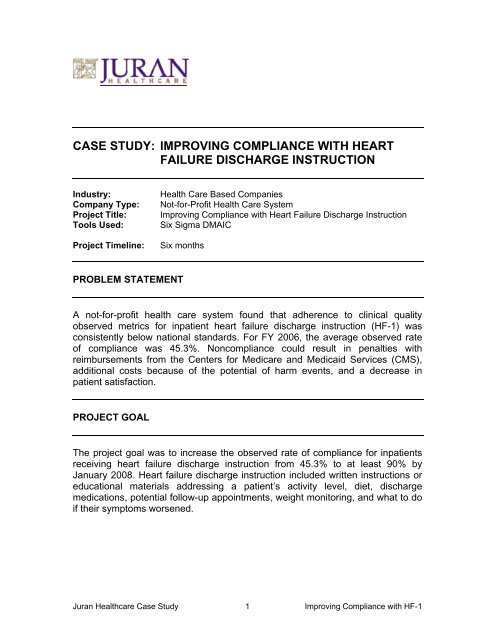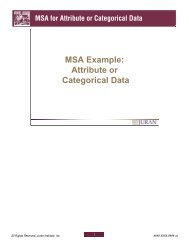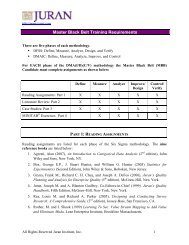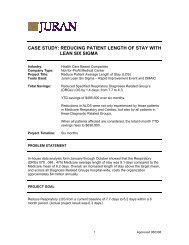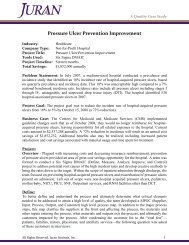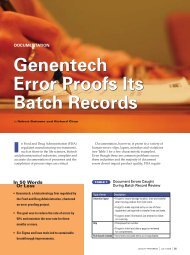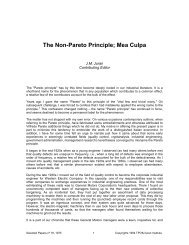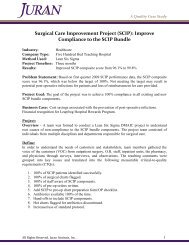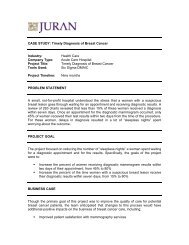Case Study Improving Compliance.pdf
Case Study Improving Compliance.pdf
Case Study Improving Compliance.pdf
You also want an ePaper? Increase the reach of your titles
YUMPU automatically turns print PDFs into web optimized ePapers that Google loves.
CASE STUDY: IMPROVING COMPLIANCE WITH HEART<br />
FAILURE DISCHARGE INSTRUCTION<br />
Industry:<br />
Company Type:<br />
Project Title:<br />
Tools Used:<br />
Project Timeline:<br />
Health Care Based Companies<br />
Not-for-Profit Health Care System<br />
<strong>Improving</strong> <strong>Compliance</strong> with Heart Failure Discharge Instruction<br />
Six Sigma DMAIC<br />
Six months<br />
PROBLEM STATEMENT<br />
A not-for-profit health care system found that adherence to clinical quality<br />
observed metrics for inpatient heart failure discharge instruction (HF-1) was<br />
consistently below national standards. For FY 2006, the average observed rate<br />
of compliance was 45.3%. Noncompliance could result in penalties with<br />
reimbursements from the Centers for Medicare and Medicaid Services (CMS),<br />
additional costs because of the potential of harm events, and a decrease in<br />
patient satisfaction.<br />
PROJECT GOAL<br />
The project goal was to increase the observed rate of compliance for inpatients<br />
receiving heart failure discharge instruction from 45.3% to at least 90% by<br />
January 2008. Heart failure discharge instruction included written instructions or<br />
educational materials addressing a patient’s activity level, diet, discharge<br />
medications, potential follow-up appointments, weight monitoring, and what to do<br />
if their symptoms worsened.<br />
Juran Healthcare <strong>Case</strong> <strong>Study</strong> 1 <strong>Improving</strong> <strong>Compliance</strong> with HF-1
The project also aimed at getting full reimbursement from the Centers for<br />
Medicare and Medicaid Services with no paybacks.<br />
Heart failure discharge instruction (HF-1) was selected as the project Y, because<br />
it contributed to 49% of defects within the heart failure category. Heart failure<br />
defect rate is shown in the following Pareto chart.<br />
Pareto C hart of H eart Failure C ategories for FY 2006<br />
700<br />
100<br />
# of Defects<br />
600<br />
500<br />
400<br />
300<br />
200<br />
100<br />
HF-1 (DC instructions) 0<br />
had the highest rate of defects compared to the 0 other<br />
HF-1<br />
HF-2<br />
HF-3<br />
HF-4<br />
three Defects heart failure quality 485 measures. 122 89 4<br />
Percent 69.3 17.4 12.7 0.6<br />
Cum % 69.3 86.7 99.4 100.0<br />
HF-1 = Discharge Instructions HF-2 = Eval of LVS HF-3 = ACEI or ARB for LV HF-4 = Smoking Cessation<br />
80<br />
60<br />
40<br />
20<br />
Percent<br />
BUSINESS CASE<br />
The Chief Financial Officer conducted a cost-of-poor-quality analysis and<br />
determined that the organization would pay back the Centers for Medicare and<br />
Medicaid Services approximately $68,000 each year if compliance scores<br />
remained at or below the 45 th percentile. There was also an associated revenue<br />
bonus opportunity for hospitals that demonstrated the greatest improvement in<br />
scores.<br />
PROJECT<br />
Overview<br />
The project team was led by the Director of Outcomes Management. The Chief<br />
Nursing Officer was selected as the project champion. The team consisted of a<br />
wide variety of clinical and support personnel. Its members represented<br />
outcomes management, nursing, respiratory, professional practice, medical staff,<br />
and finance.<br />
Juran Healthcare <strong>Case</strong> <strong>Study</strong> 2 <strong>Improving</strong> <strong>Compliance</strong> with HF-1
The project Y was the percent of correct discharge instructions for heart failure<br />
inpatients. The beginning boundary for the project was the time a patient was<br />
admitted to the hospital. The ending boundary was the time a patient was<br />
discharged from the hospital. Excluded from the project were heart failure<br />
patients discharged from the emergency department and heart failure patients<br />
with comfort measures only.<br />
DMAIC Process<br />
The team selected the Six Sigma DMAIC process as its improvement method. A<br />
Six Sigma DMAIC project is defined as a project that eliminates a chronic<br />
problem that is causing patient dissatisfaction, defects, costs-of-poor-quality, or<br />
other deficiencies in performance.<br />
Voice of the Customer and CTQ Matrix<br />
Voice of the Customer is at the heart of the Six Sigma DMAIC process – a<br />
methodical approach to understanding customer requirements. After selecting<br />
the key external and internal customers – patients, family and family caregivers,<br />
and Centers for Medicare and Medicaid Services as the most important external<br />
customers, and physicians, staff nurses, respiratory therapy, and outcomes<br />
management as the vital internal customers – the project team conducted<br />
structured interviews with members of each customer group.<br />
Following the collection of the customer “voice,” responses were then translated<br />
to the underlying key issues that the customers were communicating. For<br />
instance, a nurse stated, “We don’t have a process for heart failure discharge<br />
instruction.” The related key issue identified was “variability of discharge<br />
instruction.”<br />
Once key issues were identified, the team translated the key issues to “critical-toquality”<br />
(CTQ) needs. The key issue cited in the example above was assigned a<br />
CTQ of “having a defined process for heart failure discharge instruction.” Criticalto-quality<br />
needs were then translated into project Ys. The project Y for this CTQ<br />
was “compliance to a standardized discharge process.” The following is a<br />
snapshot of the CTQ matrix.<br />
Juran Healthcare <strong>Case</strong> <strong>Study</strong> 3 <strong>Improving</strong> <strong>Compliance</strong> with HF-1
Customer Voice of Customer Key Issues CTQ Y<br />
Nurse<br />
“Don’t have a process<br />
for heart failure<br />
discharge instructions”<br />
Variability of<br />
discharge<br />
instructions<br />
Having a defined<br />
process for heart<br />
failure discharge<br />
instructions<br />
<strong>Compliance</strong> to a<br />
standardized<br />
discharge<br />
process<br />
Patient<br />
“Informs me that I can<br />
leave at 9:30 am but I<br />
couldn’t get the<br />
discharge paperwork<br />
until 12:00 pm. I kept<br />
asking everyone that<br />
came by”<br />
Adequate ancillary<br />
support<br />
• Continuum of<br />
care<br />
• Demand match<br />
labor<br />
• Communication<br />
among<br />
caregivers<br />
Adequate<br />
staffing levels<br />
Unit<br />
Secretary/Ancillary<br />
Support<br />
“If we remember, we<br />
place them on the<br />
chart”<br />
Variability of<br />
discharge<br />
instructions<br />
• Communication<br />
among<br />
caregivers<br />
<strong>Compliance</strong> to a<br />
standardized<br />
discharge<br />
process<br />
Physicians/OM<br />
“No clear diagnosis of<br />
heart failure on<br />
admission”<br />
“No cardiac education<br />
offered seven days a<br />
week”<br />
Unclear diagnosis<br />
can cause<br />
omissions or<br />
unanticipated<br />
discharge<br />
• Evidence based<br />
practice<br />
• Diagnosis trigger<br />
• Discharge<br />
planning<br />
• Accuracy of<br />
discharge<br />
education<br />
<strong>Compliance</strong> to a<br />
standardized<br />
discharge<br />
process<br />
Cost-of-Poor-Quality (COPQ)<br />
The Chief Financial Officer calculated the cost-of-poor-quality for the project<br />
team:<br />
• The number of heart failure cases in one year = 1,214<br />
• Average Medicare reimbursement/case = $5,617.54<br />
• Total reimbursement = $6,819,693.50<br />
• 1% payback to CMS for poor performance = $68,196.94<br />
(Below the National Standards and Joint Commission public websites for<br />
heart failure discharge instructions compliance)<br />
• Defects per million opportunities (DPMO) = 546,787<br />
• Sigma Level = 1.38 (short term)<br />
Juran Healthcare <strong>Case</strong> <strong>Study</strong> 4 <strong>Improving</strong> <strong>Compliance</strong> with HF-1
Process Design<br />
The project team spent time understanding and analyzing the current process for<br />
completing the heart failure discharge instruction form. Several potential failures<br />
to the process were identified, including:<br />
• Assigning heart failure as a working diagnosis<br />
• Not putting the correct discharge instruction form on the patient chart<br />
• Heart failure discharge form not available when needed<br />
• Medication reconciliation not complete at time of discharge<br />
• Heart failure discharge instruction form missing from patient chart<br />
• Physicians discarding heart failure discharge instruction form<br />
Cause-and-Effect Diagram<br />
Using a cause-and-effect diagram, the project team identified potential causes of<br />
non-compliance with the heart failure discharge instructions:<br />
• Lack of a defined process for completing heart failure discharge instruction<br />
• Number of physicians and nurses involved in the process<br />
• Staff-to-patient ratio<br />
• Manual process for completing heart failure discharge instruction form<br />
• Level of staff education and training<br />
• Documentation issues with education, specific orders, unclear diagnoses<br />
of heart failure, etc.<br />
Failure Modes and Effects Analysis (FMEA)<br />
Failure modes and effects analysis (FMEA) is a tool that identifies possible<br />
failures in a process or product. Using FMEA, the project team identified the<br />
following as potential failures:<br />
• No heart failure discharge form available<br />
• Inadequate discharge planning<br />
• Multiple discharge forms and types<br />
• No single, definitive process owner<br />
• Lack of standardized process<br />
• Physicians discarding the heart failure discharge instructions<br />
• Medication reconciliation incomplete at time of discharge<br />
• No accountability or ownership of process compliance<br />
Juran Healthcare <strong>Case</strong> <strong>Study</strong> 5 <strong>Improving</strong> <strong>Compliance</strong> with HF-1
Vital Few Xs<br />
Utilizing Juran’s Pareto analysis, the project team was able to identify the vital<br />
few Xs that were contributing to non-compliance with heart failure discharge<br />
instruction. They found that compliance was impacted by:<br />
• The nursing unit discharging the patient<br />
• The specific type of pre-printed physician heart failure discharge<br />
instruction form<br />
• The hospital employees’ knowledge level of the six discharge instruction<br />
elements:<br />
1. A patient’s activity level<br />
2. His/her diet<br />
3. His/her discharge medications<br />
4. Any potential follow-up appointments<br />
5. His/her weight monitoring<br />
6. What a patient should do if their symptoms worsened.<br />
• Having all six discharge instructions on the various pre-printed physician<br />
cardiac forms<br />
Implementation and Control<br />
The project team developed improvement strategies for the proven vital few Xs,<br />
which included:<br />
• Standardizing the discharge process across all nursing units<br />
• Standardizing the most effective type of discharge instruction<br />
• <strong>Improving</strong> the knowledge level of the heart failure discharge instruction<br />
elements unit-by-unit with one-on-one training<br />
• Standardizing and simplifying the heart failure discharge instruction<br />
process<br />
SUMMARY OF RESULTS<br />
Based on a three-month pilot, the project was able to reach its goal of a 90%<br />
compliance rate with heart failure discharge instruction. A control plan was<br />
developed to monitor the observed rate of compliance and use of the heart<br />
failure discharge form on a monthly basis.<br />
Juran Healthcare <strong>Case</strong> <strong>Study</strong> 6 <strong>Improving</strong> <strong>Compliance</strong> with HF-1
FOR MORE INFORMATION<br />
For information on how we can help your organization attain results, please<br />
contact us at 800.338.7726 or visit us on the web at www.juran.com.<br />
Juran Healthcare <strong>Case</strong> <strong>Study</strong> 7 <strong>Improving</strong> <strong>Compliance</strong> with HF-1


